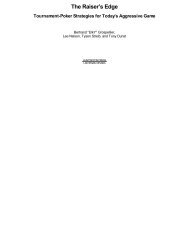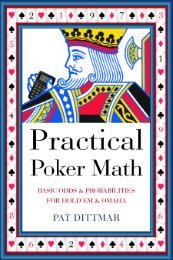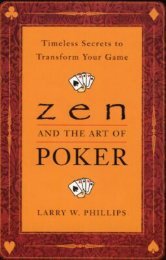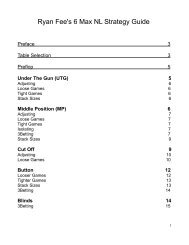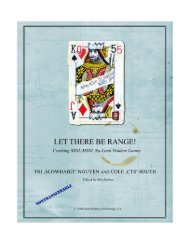You also want an ePaper? Increase the reach of your titles
YUMPU automatically turns print PDFs into web optimized ePapers that Google loves.
26<br />
Let’s look at the probability and odds against rolling the 5. The<br />
probability is 1<br />
, and the odds against are 5:1. Notice if you add<br />
6<br />
together the two numbers in the ratio you get the bottom number<br />
of the probability fraction. This is because the number of times<br />
something doesn’t happen plus the number of times something<br />
does happen equals all the times possible. And the bottom<br />
number of the probability fraction represents to the total possible<br />
outcomes. Now, the right number of the ratio is the number of<br />
times it did happen. This is the same number represented by the<br />
top of our probability fraction. So, we can then see how to<br />
convert a ratio to a fraction.<br />
Let’s take the ratio 6:1. What would the corresponding fraction<br />
be? We know this ratio is telling us something doesn’t happen<br />
six times and does happen one time. This means there are seven<br />
total chances. So, that’s the bottom number of the probability<br />
fraction. The right number of the ratio lets us know this thing<br />
happens one time, which is what we’re after on the top of our<br />
fraction. So, saying 6:1 is the same as saying 1<br />
. Let’s just take<br />
7<br />
this one step further and convert a fraction to a ratio.<br />
Let’s take the fraction 1<br />
. What is the corresponding ratio? Let’s<br />
3<br />
do the easy part first and put the one on the right side of the ratio<br />
(?:1). This tells us the thing will happen one time. Now, if<br />
something will happen one time out of three, how many times<br />
will it not happen? Here we take the three total chances and<br />
subtract the one time is happened and we see that it did not<br />
happen two times. So, two is the number of the left side of our<br />
ratio. The probability 1<br />
can be said as 2:1 against.<br />
3<br />
Let’s do one more of these. Let’s take the fraction 2<br />
. Again, the<br />
5<br />
easy part first and put the two times it does happen on the right<br />
of our ratio (?:2). Then we need to find out how many times it





